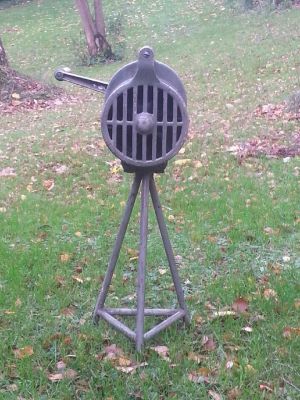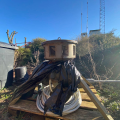DISA
| DISA Industries A/S | |
| [[File:|200px]] | |
| Names | Compagnie Madsen A/S (1900-1936)
Dansk Rekyl Riffel Syndikat A/S (1936-2005) DISA Industries (2005-present) |
|---|---|
| Headquarters | Højager 8, 2630 Taastrup, Denmark |
| Founded | 1900 |
| Products | Metal casting products |
Dansk Industri Syndikat, commonly shortened to DISA, is a Danish manufacturer of metal casting products. During World War II, they were contracted by the Danish government to produce air raid sirens to warn the public of German air raids. Numerous sirens were produced by DISA during the war, including hand crank and gas-powered sirens. However, info on much of these has been lost to time or is very hard to come by, and as a result only 3 sirens are known to have been produced by them.
History
DISA was founded in 1900 as the Compagnie Masden, producing Vilhelm Hermann Oluf Madsen's air-cooled, recoil-repeating machine gun, also named the Masden. Just before and during the occupation of Denmark by Germany, the Danish government commissioned DISA to produce and install air raid sirens across the country, and its factory in Copenhagen was used to make weapons. The production of these sirens would cease after the war, as there was no real purpose for them anymore. From there, DISA would go on to produce DISAMATIC forming machines and other foundry equipment to this day.
Products
Stationary Electric Sirens
E37
The E37 is an omnidirectional siren produced by DISA during WWII. The siren is simple in terms of design, with a small motor on top of a large round stand driving a small 8 port rotor obscured by 2 shrouds to protect the siren from the elements and to better propagate the sound. It can be assumed they were discontinued when World War II ended in 1945. Around 500[1] were produced, and very few, if any, remain today.
E37D
The E37D is another omnidirectional siren produced by DISA, being relatively similar to the E37, with the exception of a large mesh screen surrounding the siren's stator. Aside from this, the siren is relatively identical to the E37. The siren is able to be heard from up to 0.8 kilometers (0.4 miles) and weighs 140 kilos. Similarly, around 500 units were produced.[1] It can be assumed they were discontinued when World War II ended in 1945. Several units still exist today, with one being located at the Zeppelin Museum in Denmark.
LS 8
The LS 8 is another siren produced by DISA. Due to a lack of information, little to nothing is known about this siren. Little to none of these are known to exist. The LS 8 was mentioned in a manual for the BD 8[2], but aside from this, nothing else is known about them. It can be assumed they were discontinued when World War II ended in 1945.
LS 8D
The LS 8D is presumably a variant of the LS 8. Like its counterpart, little to nothing is known about it. Only 71 LS 8Ds were made.[3] It can be assumed they were discontinued when World War II ended in 1945.
Gas Powered Sirens
BD 8
The BD 8 is a gas-powered mobile siren produced by DISA and is arguably their most well-known. The main purpose of the BD 8 was to alert the Danish population in the event that stationary sirens were not able to function for whatever reason. Interestingly, mobile gas-powered sirens like the BD 8 had to be transported on the bed of a pick-up truck or small cargo truck, as it was illegal to transport them via moped or motorcycle.[1] The BD 8 makes use of a single-cylinder two-stroke type MK.25C Villiers petrol engine directly coupled to the rotor. It has an 8 port chopper and stator that can have the pitch and sounds output controlled by the throttle as well as a manually controlled shutter to close off the ports. A "special ignition key" is required to start the motor.
A pulley for starting the engine is attached to the crankshaft, provided with a notch for a pawl, so that the piston, when the engine is not in operation, can be moved to cover the siren's ports with a code ring, located around the siren's stator. The siren's fuel tank can hold a volume of 2.51 liters. The entire unit is attached to a two-wheeled cart which allows the siren to be transported to multiple locations. It can be assumed they were discontinued when World War II ended in 1945. Today, a handful of units exist, with a few going to museums and at least 2 being privately owned.
Hand Operated Sirens
Hand operated siren

One particular model of hand operated siren is known to have been produced by DISA during the time they manufactured air raid sirens during World War II. Due to a lack of information regarding this siren, its model name is unknown. The siren utilizes a small, what looks to be 6 or 8 port rotor, which is driven by a hand crank with a wooden handle at the back of the siren. On the top of the stator, there is a small handle that allows for the siren to be carried. The siren is held up by a small 3-legged metal stand. There is a mesh screen surrounding the ports of the stator, as the siren is small enough to be handheld and could potentially cause injury if misused. There is also a grille on the front of the stator because of this.
Below the base of the hand crank on the back of the siren, there is a small DISA logo and a tag that reads "Dansk Industri Syndikat", as well as smaller text below reading "Taastrup". These hand crank sirens were produced from 1935 to 1942. 500 of them were made, but only 1 is known to exist as of today.
Gallery
-
An E37D without the mesh screen.
-
An E37D on top of a building.
-
An E37D on top of a building.
-
A DISA siren on top of a windmill.
-
A DISA siren on top of a building.
-
A DISA siren on top of a building.
